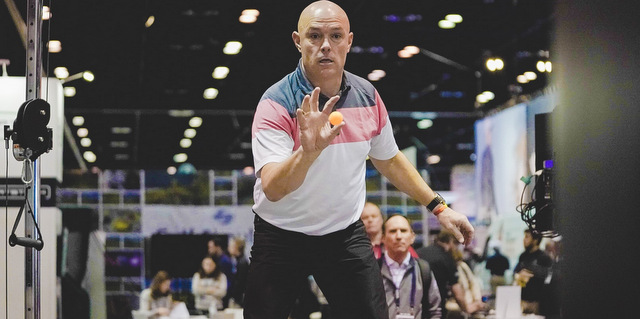IMPROVE MY GAME
Articles
Catching Ping Pong Balls To Improve Quiet Eye For Golf

Liam Mucklow is a speaker at the 2018 World Golf Fitness Summit and will be presenting on techniques to develop hand eye coordination, including the Ping Pong Ball catching protocol outlined in this article. For more information on the WGFS and the roster of speakers, visit our site: www.mytpi.com/wgfs
At the 2018 PGA Merchandise show I was fortunate to have the opportunity to demonstrate the catching protocol we use with all of our players at The Golf Lab in Toronto, Canada. Now before we get started I need to make sure everyone knows that I didn’t invent this, it came from the mind of my good Icelandic friend, and TPI Certified Professional, Gauti Gretarsson. Gauti is a crazy many that has developed multiple Olympians in 5 different sports from the country of Iceland! They have a population of under 350,000, roughly 1/1000th the number of people living in the United States or the same population as Saskatoon, Saskatchewan……
Here's a clip of the Ping Pong Catching Protocol from my presentation at the PGA Show.
Ping Pong Catching from The Golf Lab on Vimeo.
We have created 10 standardized levels that people have to go through as a tool for us to gauge their hand-eye coordination, spatial awareness, and visual acuity. If you want to learn more about this type of thing I would suggest checking out The Quiet Eye studies by Dr. Joan Vickers of the University of Calgary. It has been shown to be a key differentiating factor between elite and sub-elite performers in a variety of sports including golf, basketball, tennis, bowling and even in non-sporting environments like surgery.
The Quiet Eye (QE) refers to the final fixation of eye movement at least 100 milliseconds prior to movement. Longer QE duration is exhibited by experts in comparison to non-experts.
"When your eyes provide the data, your motor system just knows what to do. Your brain is like a GPS system. It detects target, speed, intensity, and distance.
- Joan Vickers
Now is when you may be asking, “How does this apply to golf?” For the last two years at The Golf Lab we have been integrating this catching protocol to improve the QE in our clients. It has been fascinating to see the improvements in striking accuracy of players across a wide bandwidth of skills. We have seen significant improvement in the golfers ability to control impact point on the club face. Check out these impact patterns from golfers of different levels, from PGA TOUR to casual golfer.

This has been so impactful for our training because we also know that the single biggest difference between a PGA Tour player and an amateur is the Standard Deviation of Impact Point. When Amateur golfers have a more consistent impact point they are able to hit the ball farther and straighter! Most of the QE research you will see pertains to putting, but developing this is an easy, and fun, way to help your golfers hit the ball farther for years to come.
Ping Pong Catching - Level 11 from The Golf Lab on Vimeo.
In this article I thought it would be interesting to focus on all the other things we learn using this test, most notably about peoples emotional responses to failure. The night after the demonstration at the PGA Show I was at dinner with Erik Blomqvist from Sweden, the second last person in the video, and he was talking about some post content reflection. Erik was telling me about how similar his response was to missing a golf shot as it was to missing a ping pong ball. Tension crept in, his body tightened up, his mind drifted into technical thoughts. All of these are detrimental to performance.
I really enjoyed hearing those thoughts from such a high level European golf coach. On a personal level it helped validate and justify more of these crazy games we make our students play, but what can you take away from it? First off, this type of game can be used to develop skills like hand eye coordination that are essential for golf performance. Second is that by using gaming-based practice and contests with your students you can actually make them better competitors, they will practice with consequence. The final benefit, and perhaps most important, is that its FUN! Just look at the reaction of everyone in the video.
